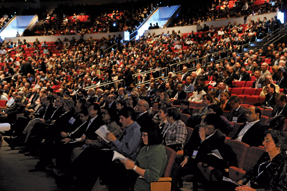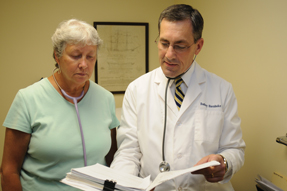Lack of kidneys for transplant raises debates
A shortage of transplantable organs has led to previously unthought-of issues that entangle ethics, policy, costs and clinical complications. Internists now must consider transplant tourists, long waits and “donation chains” as factors in their patient counseling.
The U.S. dialysis population continues to grow, topping 380,000 in 2008. With not enough kidneys available to meet transplantation needs, issues of access and ethics will increasingly need to be addressed.
While resolving these issues may seem like a task for medical ethicists and policymakers, practicing internists may also find themselves entangled in these complex decisions.

For example, what should a physician do when a patient reveals her plan to go to India or Pakistan for a kidney transplant? Advise against it, said Francis L. Delmonico, MD, emeritus director of renal transplantation at Massachusetts General Hospital in Boston.
Dr. Delmonico was one of several speakers who updated attendees on the current state of kidney transplantation at the American Society of Nephrology's annual meeting, held in Denver last November.
Transplant tourism
There are a number of problems with traveling overseas for a kidney transplant, Dr. Delmonico noted. As with any medical tourism, there's the risk of acquiring and transmitting infectious disease. “The new superbug from India [antibiotic-resistant gene New Delhi metallo-beta-lactamase] could spread around the world,” said Dr. Delmonico. “We have strongly suggested that the U.S. government be concerned about transplant tourism because of the public health hazard. Transplant tourists could be bringing home esoteric bacteria, tuberculosis, hepatitis, HIV, etc. unwittingly.” Recently there were two cases in Israel in which patients returned home from Egypt with hepatitis C virus and died.
Physicians should make these risks clear to any patient who's considering leaving the country for a transplant. “We have a professional responsibility to alert them to the hazards: Your transplant is not going to be done in a Medicare-approved facility that is regulated and has performance measures,” said Dr. Delmonico.
The possibility that an organ could come from a prisoner or an unwilling donor raises the other major problem with the international transplant trade. “If you go to China, malignancy could be transmitted from the executed prisoner, and if you're dealing with bonded laborers, how do we know what their health status could be?” Dr. Delmonico asked.
He continued, “Transplant tourism is different from medical tourism because it involves a donor. [The donors] can be minors; can be illiterate; they can be impoverished.”
Disadvantaged living donors who sell their organs and don't receive adequate follow-up often suffer negative health effects, which is why most countries have outlawed this practice. “Other than Iran, there is no government that is going to accept the so-called market of organs as a solution to donation needs,” said Dr. Delmonico.
Even in cases where organs aren't being sold, transplant tourism hurts potential domestic recipients. “Rich people come along and they're preferentially cared for. If you can go to Colombia and get yourself an organ, what about the Colombians who need organs?” Dr. Delmonico asked.
More than 70 countries gathered in 2008 to express their opposition to transplant tourism in an agreement known as the Declaration of Istanbul. Another product of the gathering was a patient brochure titled, “Thinking of buying a kidney? Stop.” The brochure is available for download online and it's one option for a physician trying to dissuade a patient from transplant tourism.
Since transplants involving sale of organs are illegal in most of the destination countries, U.S. internists can express their disapproval in other ways, too. “They don't necessarily have to subscribe to this. They don't have to provide medical records for it. They don't have to be a component of what might be a felony in another country,” said Dr. Delmonico.
However, if patients go ahead with the transplant or don't provide any advance warning of their intentions and come home with complications, physicians do have a responsibility to help them. “Can you say because you've come from China or the Philippines, I don't have to take care of you? No,” Dr. Delmonico said.
Payers, on the other hand, are not under the same obligation, and Dr. Delmonico called on them to take action to make transplant tourism less appealing. “HHS [the Department of Health and Human Services] could restrict Medicare coverage of immunosuppressive medications to be provided for transplants only performed in Medicare facilities,” he said. The government could also prohibit U.S. insurance companies from paying for any part of overseas transplants.
The government should also take a look at the reverse form of transplant tourism, foreigners coming to the U.S. for organs, Dr. Delmonico advised. Research indicates that such transplants probably represent fewer than 1% of the total done in the U.S., but anecdotal reports show a need for more specific data.
“What we should be doing is seeing the patterns of referral and if they are systematized approaches of one particular country sending patients to a particular center in the U.S., it can clearly disadvantage American patients,” he said.
A long wait
Americans in need of a kidney already have an uphill battle, other speakers at the meeting made clear. Garet Hil, founder of the National Kidney Registry, first researched transplant rates when his 10-year-old daughter needed a kidney. He called transplant centers around the country and was dismayed by his findings: His daughter had a one in ten chance of getting a transplant over the next 12 months.
The wait time for a paired exchange kidney transplant (in which a patient receives a kidney from a living compatible donor) averaged four to ten years in 2007, he reported. Given that research has shown lower mortality in patients who receive transplants and worse outcomes the longer patients wait, this delay poses problems for all potential recipients.
But it's particularly an issue for elderly patients, according to Gabriel Danovitch, MD, director of the renal transplant service at the University of California, Los Angeles. “If you're putting a patient on the list in their mid-70s, and in our program they're going to wait eight years, they're going to be 83 or 84 [when they get a kidney]. Is there any point in going through this exercise?”
Elderly patients may also fare worse after transplants, at least in part because they are more likely to get older kidneys, Dr. Danovitch explained. In addition to providing realistic information about likely outcomes, physicians need to consider the other options available to these patients. “Given the prolonged wait for deceased donor kidneys and the likelihood that for the elderly the organ will be of suboptimal quality, to what extent should living donation be encouraged?” Dr. Danovitch asked.
But finding a living donor—most likely a relative of the recipient—raises other dilemmas, he continued. “What are the ethical issues involved in transplanting younger people's kidneys into patients in their mid-70s or 80s whose intrinsic lifespan is limited? It's a challenge.”
These patients are aware of the sacrifice they'd be asking from donors and therefore are often reluctant to ask their families to donate, Dr. Danovitch said. “They don't want to turn to their children, but they realize that they don't want to wait for 8, 9, 10 years to get a poor-quality kidney from a deceased donor. So it's a tough dilemma,” he added.
Solutions for the future
One solution to the shortage of kidneys, both for older patients and younger, would be finding more people willing to donate. Rates of living donation, particularly by people who aren't related to organ recipients, had been on the rise until recently, Dr. Danovitch reported.
“There seems to have been a stabilizing, and even a falloff, of living donation in the last year or so. This is very, very worrisome considering the size of waiting lists. We don't know why,” he said.
Although he didn't have an explanation for the trends in kidney donation, Dr. Danovitch did have some suggestions for how to turn it around. A national promotional campaign for living donation in the Netherlands succeeded in shrinking the waiting list and could be a model for the U.S., he said. (Such initiatives should only be attempted in developed countries to avoid the risk of encouraging coerced or paid donations, he noted.)
More targeted efforts may also be appropriate. While the population of patients needing kidneys is disproportionately black and Hispanic, kidney donors are mainly white. That may be because kidney donation, in contrast to kidney disease, is less common among the poor. “Many programs are uncomfortable taking donors if they don't have health insurance,” Dr. Danovitch said.
Minorities may also be unaware of the possibility of donation. Dr. Danovitch described a recent study that involved investigators going to the homes of patients of minority races to educate them about kidney donation. “The home-based education increased the actual number of transplants,” he reported.
By founding the National Kidney Registry, Mr. Hil has also found a major way to increase the rates of living kidney donation. The registry organizes donation chains, which are made up of patients in need of kidneys who have a friend or relative who is willing to donate but is not a match. The donor gives a kidney to another patient in the registry, whose friend or relative in turn gives a kidney to a different patient in need, and so on down the line. (The first kidney in the chain is provided by what's known as an altruistic or Good Samaritan donor, who gives without a connection to a recipient.)
This strategy can facilitate many more transplants than traditional paired exchange, in which a patient needs a willing and perfectly matched donor. The registry's longest chain, completed last year, included 44 participants.
“Donor chains are so much more powerful at finding matches that we only do traditional paired exchange in very unique situations,” said Mr. Hil. “We're on track to finish the year with 153 transplants facilitated this year. We're forecasting 310 transplants next year, which will equate to 5% of the living donor transplants in the U.S.”
The disadvantage of donor chains is that they do occasionally break, with one of the planned donations not taking place. The National Kidney Registry has had six broken chains—a couple because donors reneged, others because of medical issues or long delays in finding compatible recipients. The goal is to complete a chain quickly to reduce the risk that it will break, Mr. Hil explained.
Picking up the pace
The registry process does move much more quickly than typical organ waiting lists. “In the National Kidney Registry, you get an average wait time of eight months. That's pretty good, but not good enough. We need to drive that down well below six months,” Mr. Hil said.
His plan for accomplishing that ambitious goal is to increase enrollment of compatible pairs in donation chains. Here's how it works: In the current pool of potential donors and recipients, there's always a shortage of donors with blood type O and recipients with blood type A, because they match with so many people. So if you had a husband who was an O donor and a wife who was an A recipient, currently they would match with each other, he'd give her the organ and they'd have no effect on the rest of the kidney waiting list.
But under the new system, the couple, who are compatible with each other but also many other people, could be used to facilitate more donations. “If you take that compatible pair and drop them into a pool of 100 incompatible pairs, that one pair can facilitate five to 10 more transplants. It gets a lot of incompatible pairs transplanted because it's counter to the shortage,” Mr. Hil explained. The strategy would also benefit the original type A recipient, because she would likely be matched with a donor who was an even better match with her than her husband (by being closer to her age or a better human leukocyte antigen match, for example).
Mr. Hil has high hopes for the potential of this system. “This will dramatically change the living donor transplant industry over the next 10 years,” he concluded.





